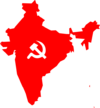- Communist Party of India (Marxist–Leninist) Second Central Committee
-
Communism in India Communist Party of India
AITUC - AIKS - AIYF
AISF - NFIW - BKMUCommunist Ghadar Party of India
Naxalbari uprising
Communist Party of India (M-L)
Liberation - New Democracy
Janashakti - PCC - 2nd CC
Red Flag - Class Struggle
Communist Party of India (Maoist)Socialist Unity Centre of India (Communist)
AIUTUC - AIMSS
AIDYO - AIDSOM. N. Roy
Abani Mukherji
A. K. Gopalan
P. Krishna Pillai
P. C. Joshi
P. Sundarayya
Ajoy Ghosh
K. Damodaran
E. M. S. Namboodiripad
Chandra Rajeshwar Rao Azhikodan Raghavan
Bhupesh Gupta V. S. Achuthanandan
E. K. Nayanar
Guru Radha Kishan
B. T. Ranadive
Charu Majumdar
Jyoti Basu
S. A. Dange
Shibdas Ghosh
E. K. Imbichi Bava
T. Nagi ReddyTebhaga movement
CCOMPOSA
Telangana Rebellion
Comrades Association
Communist Party of French IndiaCommunism
World Communist MovementCommunism Portal
Communist Party of India (Marxist-Leninist) Second Central Committee, was an naxalite communist party in India. The party emerged in 1972, as the CPI(ML) was divided into pro- and anti-Lin Biao factions (the CPI(ML) 2nd CC represented the pro-Lin Biao stream). The party was active in states like Bihar and West Bengal.The original Communist Party of India (Marxist-Leninist) had been formed in 1969 by the All India Coordination Committee of Communist Revolutionaries, who had split from Communist Party of India (Marxist) in 1967. CPI(ML) advocated armed struggle and condemned participation in parliamentary elections and work in mass movements. The party was divided first when Satyanaran Singh rejected Charu Majumdar's leadership. Then in 1972 the remainder of the pro-Majumdar CPI(ML) was divided into pro- and anti-Lin Biao factions. Mukherjee led the pro-Lin Biao group.
Mukherjee's faction organized its '2nd party congress' in December 1973. The congress reaffirmed the programme of the CPI(ML) adopted in 1970 and the line of Lin Biao. The party launched a wave of weapon snatches, attacks on police, prison escapes and annihilations. In 1973 10 policemen in West Bengal were killed by the party and there were 39 incidents of gun snatchings.[1]
In the late 1970s, Central Committee members Azizul Haque and Nishit Bhattacharya expelled Mukherjee (who reorganized his grouping, the Communist Party of India (Marxist-Leninist) (Mahadev Mukherjee).[2]
Fronts of the CPI(ML) 2nd CC included Gansangram Komiti (Peoples Struggle Committee), Biplobi Krishak Front (Revolutionary Peasants Front), Chetna Sanskritik Manch and Kisan Mazdoor Mukti Morcha (Peasants Workers Liberation Front).
It published Jandisha (in Hindi) and Janedisha (in Bengali) through its fronts.
On May 19, 2003 CPI(ML) 2nd CC merged with Maoist Communist Centre of India. CPI(ML) 2nd CC had to withdraw its pro-Lin Biao stand for the merger to go through.
References
- ^ Singh, Prakash, The Naxalite Movement in India. New Delhi: Rupa & Co., 1999, ISBN 978-81-7167-294-3, p. 95.
- ^ naxalism today
Categories:- Political parties established in 1972
- Communist parties in India
- Naxalite-Maoist insurgency
Wikimedia Foundation. 2010.

